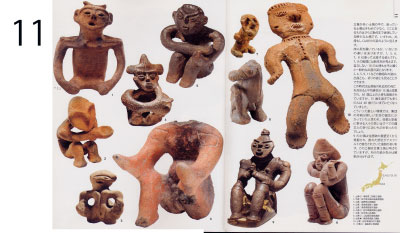The majority of clay figurines are in a standing posture so ones in a sitting position are a rare find. These clay figurines sited here are even more unusual, showing their motions. Each of them appears to express childbirth or prayer.
Clay figurines with numbers, 1 (top, p. 10), 3 (bottom left, p. 10), 6 (bottom right, p. 10), 7 (top left, p. 11), and 8 (left, second from top, p. 10) are thought to be showing a sitting childbirth posture with the buttocks either on the floor or not. Nos. 7 and 8 show a newborn baby coming out of the vagina. Clay figurine No. 10 (top right, p. 11) cannot sit or stand upright on its own, but we can see that it depicts a common childbirth position when laid on its backside. The crossing of arms in Nos. 2 (left, second from top, p. 10), 4 (center middle, p. 10), 5 (top left, p. 10), 9 (bottom left, p. 11), and 11 (bottom right, p. 11) can be considered to express prayer or giving birth.
With early infant death included, the average lifespan of the Jomon people has been estimated to be fifteen years. While there are some cases of bones of humans over sixty-five years old having been excavated, most of those that made it past the average lifespan did not live past forty.
We can imagine that, under the severe environments for survival, the existence of each group of people all depended on the birth of new life, and that their wish for a pregnancy and easy delivery were always in their prayers
Clay figurine No. 9 was excavated from the back wall area of a pit dwelling site. It has traces of asphalt being used to bond broken parts. This clay figurine is referred to as gassho (prayer hands) dogu, although opinion on whether it shows prayer or not is divided.
